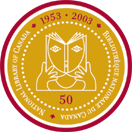
|
September/October 2003
Considering Canada:
|
|||||||||||||||||||
|
You may be surprised to hear that Canadian picture books have been around since the mid-19th century. According to Jeffrey Canton, guest speaker at the Library and Archives Canada (LAC) SAVOIR FAIRE lecture series, An Illustrated Comic Alphabet, created by Amelia Howard-Gibbon in 1859, was inspired by the classic English rhyme "Tom Thumb’s Alphabet" and by her childhood memories of growing up in Sussex, England.
It is believed that Miss Howard-Gibbon, a private drawing tutor/teacher in Sarnia, Ontario, crafted her comic alphabet either for the benefit of her students or simply to lessen her longing for her homeland. In 1865, she presented a worn drawing book with a small inscription inside to a friend, as a Christmas gift. Sadly, this book remained unpublished for more than a hundred years. With Amelia Howard-Gibbon's gem as a starting point, Jeffrey Canton’s presentation offered an overview of Canadian alphabet books, covering different eras and themes.
Early ABCs
Charming and subtle, yet humorous and playful, An Illustrated Comic Alphabet provides children with a diversion while introducing them to the mechanics of spelling.
Amelia Howard-Gibbon’s ABC book was truly a unique picture book for its time: very few Canadian children’s books were published prior to the 1960s. Another exception is A Canadian Child’s ABC. Written by R.K. Gordon and illustrated by Thoreau MacDonald, son of Group of Seven member J.E.H. MacDonald, it was published in 1931. Inside, one finds wonderful poems such as the "hymn to the beaver" and a "poem to Ottawa." The book invokes a keen sense of place, stirring feelings of national pride and identity.
Jeffrey Canton explained that a handful of other picture books were also written during this time, however they were much more didactic, moralistic and conscious of class, societal roles and divisions. They contained little of the charm evident in the Howard-Gibbon and R.K. Gordon books: Christie Cookies published an alphabet book on baking cookies, and London Life produced an alphabet book promoting the benefits of knowing the right people. Very few books were written with children in mind during this period of time.
In 1968, the University of Toronto Press produced Anne and Alexander Wyse’s Alphabet Book, a beautifully crafted alphabet book for a small hand. A group of children from southwestern Ontario worked on the design of this simple and appealing book.
Louise Ellis’s 1976 alphabet book, entitled Alphavegetabet, incorporates a series of poems celebrating vegetables. Fun and playful, it includes an homage to the tomato.
A Sense of Place
Ann Blade’s By the Sea is a celebration of shape and vibrant colour. It provides readers with a keen sense of place and includes beautiful illustrations showcasing Vancouver’s beaches, British Columbia’s orca whales, the north-shore mountains, and a blue sky. Blade’s illustrations give a visual sense of the Canadian landscape, including trees, animals, sporting activities and the importance of the environment, while her text reflects children’s values.
Seaside Alphabet Book, by Donna Grassby and illustrated by Susan Tooke, is a sophisticated picture book that may appeal to older children (it is very similar to a Where’s Waldo book).
ABCs as Teaching Tools
ABC des petits Canadiens, published in 1933, highlights heroes of the francophone past (such as Samuel de Champlain) and icons of Canadian traditions (i.e., maple syrup, forests and moose). While this alphabet book may have been originally intended as a teaching tool, it also defines us as Canadians by our values and our landscape.
L’abécédaire des animots, by Marjolaine Bonenfant and Robert Soulières, is charming and appealing on many levels: it may delight a child and impress an adult with its sophistication. Ted Harrison’s black-and-white illustrations in A Northern Alphabet are fun, and his simple line drawings provide humour. These are teaching tools with an imaginative sense of play.
Just for Fun
Roger Paré’s L’Alphabet is light and whimsical in its approach to sharing the alphabet with a small child. It has even been adapted into a children’s game.
Truly Canadian
Eh? to Zed by Kevin Major is a rhyming alphabet book that presents Canada as immense and culturally diverse. Stéphane Poulin’s Ah Bell Cité combines a sense of play with Canadian identity. Trunks All Aboard, written by Barbara Nichol and illustrated by Sir William Cornelius Van Horne, and L’abécédaire de Pitatou, written by Louise Pomminville, were also mentioned as being markedly Canadian. M is for Maple is by a Canadian author but destined for the United States, having been designed to enlighten the reader about things distinctly Canadian.
When compared with alphabet books from England and the United States, Canadian ABCs place more emphasis on sense of place. However, within Canada the styles are somewhat different across cultural boundaries: English Canadian writers tend to use alphabet books more often as teaching tools, while French Canadian authors are more lively, edgy and playful, exhibiting a European influence.
Canton explained that alphabet books are one of the most under-represented genres of literature. Despite being powerful vehicles in defining Canadian values, very little has been written about Canadian ABCs.
In his conclusion, Canton identified several key ingredients that make a good alphabet book: lively pictures, witty text, humour, and characters that come alive in poems. With their sense of imagination or play, Canadian alphabet books appeal to most children; however, with their strong sense of place and Canadian landscapes, they can also charm adults.
__________
Jeffrey Canton, editor of Books in Canada’s children’s section, was the guest curator of the exhibition Beyond the Letters: Retrospective of Canadian Alphabet Books, which ran from June 2 to September 8, 2003, at Library and Archives Canada. He presented his overview of Canadian alphabet books on Tuesday, June 17, 2003, at Library and Archives Canada in Ottawa.
A Web site based on the Beyond the Letters exhibition can be found on the LAC Web site at www.nlc-bnc.ca/abc.